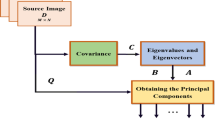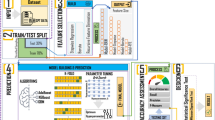Abstract
In this paper, a novel spectral-spatial hyperspectral image classification method has been proposed by designing hierarchical subspace switch ensemble learning algorithm. First, the hyperspectral images are processed by fast bilateral filtering to get the spatial features. The spectral features and spatial features are combined to form the initial feature set. Second, Hierarchical instance learning based on iterative means clustering method is designed to obtain hierarchical instance space. Third, random subspace method (RSM) is used for sampling the features and samples, thereby forming multiple sub sample set. After that, semi-supervised learning (S2L) is applied to choose test samples for improving classification performance without touching the class labels. Then, micro noise linear dimension reduction (mNLDR) is used for dimension reduction. Afterwards, ensemble multiple kernels SVM(EMK_SVM) are used for stable classification results. Finally, final classification results are obtained by combining classification results with voting strategy. Experimental results on real hyperspectral scenes demonstrate that the proposed method can effectively improve the classification performance apparently.








Similar content being viewed by others
References
Cui M, Prasad S (2015) Class-dependent sparse representation classifier for robust hyperspectral image classification. IEEE Trans Geosci Remote Sens 53(5):2683–2695
Li C et al (2015) Hyperspectral image denoising using the robust low-rank tensor recovery. J Opt Soc Amer A 32(9):1604–1612
Muller-Karger F et al (2013) Satellite remote sensing in support of an integrated ocean observing system. IEEE Geosci Remote Sens Lett 1(4):8–18
Leeuwen M, Nieuwenhuis M (2010) Retrieval of forest structural parameters using Li DAR remote sensing. Eur J Forest Res 129(4):749–770
Zhang C, Kovacs JM (2012) The application of small unmanned aerial systems for precision agriculture: a review. Precis Agric 13(6):693–712
S Amini S, Homayouni A (2014) Safari, Semi-supervised classification of hyperspectral image using random forest algorithm, Geoscience and Remote Sensing Symposium (IGARSS), pp 2866–2869
Archibald R, Fann G (2007) Feature selection and classification of hyperspectral images with support vector machines. IEEE Geosci Remote Sens Lett 4(4):674–677
Chen Y, Nasrabadi NM, Tran TD (2013) Hyperspectral image classification via kernel sparse representation. IEEE Trans Geosci Remote Sens 51(1):217–231
Chen C et al (2014) Spectral-spatial classification of hyperspectral image based on kernel extreme learning machine. Remote Sens 6(6):5795–5814
Ghamisi P, Benediktsson JA (2015) Feature selection based on hybridization of genetic algorithm and particle swarm optimization. IEEE Geosci Remote Sens Lett 12(2):309–313
Nguyen TM, Wu QMJ (2012) Gaussian-mixture-model-based spatial neighborhood relationships for pixel labeling problem. IEEE Trans Syst Man Cybern 42(1):193–202
Chen C et al (2014) Spectral-spatial preprocessing using multihypothesis prediction for noise-robust hyperspectral image classification. IEEE J Sel Top Appl Earth Observ 7(4):1047–1059
Fauvel M, Benediktsson JA, Chanussot J, Sveinsson JR (2008) spectral and spatial classification of hyperspectral data using SVMs and morphological profiles. IEEE Trans Geosci Remote Sens 46(11):3804–3814
Tarabalka Y, Chanussot J, Benediktsson JA (2010) Segmentation and classification of hyperspectral images using watershed transformation. Pattern Recognit 43(7):2367–2379
Fang L, Shutao Li, Kang X, Benediktsson JA (2014) Spectral-spatial hyperspectral image classification via multiscale adaptive sparse representation. IEEE Trans Geosci Remote Sens 52(12):7738–7749
Kang X, Li S, Benediktsson JA (2014) Feature extraction of hyperspectral images with image fusion and recursive filtering. IEEE Trans Geosci Remote Sens 52(6):3742–3752
Lin CH, Tsai JS, Chiu CT (2010) Switching bilateral filter with a texture/noise detector for universal noise removal. IEEE Trans Image Process 19(9):2307–2320
Chaudhury KN, Dabhade SD (2016) Fast and provably accurate bilateral filtering. IEEE Trans Image Process 25(6):2519–2528
Ye Z, Li H, Song Y, Wang J, Benediktsson JA (2016) A novel semi-supervised learning framework for hyperspectral image classification. INT Jwavelets Multi 14(02):15–31. https://doi.org/10.1142/S0219691316400051
Ma L, Ma A, Ju C, Li X (2016) Graph-based semi-supervised learning for spectral-spatial hyperspectral image classification. Pattern Recogn Lett 83:133–142
Samat A, Du P, Liu S, Li J (2014) Ensemble extreme learning machines for hyperspectral image classification. IEEE J-STARS 7(4):1060–1069
Zhang E, Zhang X, Jiao L, Li L, Hou B (2016) Spectral–spatial hyperspectral image ensemble classification via joint sparse representation. Pattern Recogn 59(C):42–54
Liu T, Gu Y, Jia X, Benediktsson JA, Chanussot J (2016) Class-specific sparse multiple kernel learning for spectral–spatial hyperspectral image classification. IEEE Trans Geosci Remote Sens 54(12):7351–7365
Gu Y, Liu T, Jia X, Benediktsson JA, Chanussot J (2017) Nonlinear multiple kernel learning with multiple-structure-element extended morphological profiles for hyperspectral image classification. IEEE Trans. Geosci. Remote Sens 54(6):3235–3247
Li C, Ho HH, Kuo BC, et al. (2015) A semi-supervised feature extraction based on supervised and fuzzy-based linear discriminant analysis for hyperspectral image classification. Appl Math Inf Sci 9(1L):81–87
Appice A, Guccione P, Malerba D (2017) A novel spectral-spatial co-training algorithm for the transductive classification of hyperspectral imagery data [J]. Pattern Recogn 63:229–245
Appice A, Guccione P, Malerba D (2016) Transductive hyperspectral image classification: toward integrating spectral and relational features via an iterative ensemble system [J]. Mach Learn 103(3):343–375
Guccione P, Mascolo L, Appice A (2015) Iterative hyperspectral image classification using spectral–spatial relational features[J]. IEEE Trans Geoscience Remote Sens 53 (7):3615– 3627
Pasolli E, Melgani F, Tuia D et al (2014) SVM Active learning approach for image classification using spatial information [J]. IEEE Trans Geoscience Remote Sens 52(4):2217–2233
Pasolli E, Yang HL, Crawford MM (2016) Active-metric Learning for classification of remotely sensed hyperspectral images [J]. IEEE Trans Geoscience Remote Sens 54(4):1925–1939
Pan B, Shi Z, Xu X (2017) Mugnet: deep learning for hyperspectral image classification using limited samples [J]. ISPRS J Photogrammetry Remote Sens
Chen Y, Lin Z, Zhao X et al. (2017) Deep learning-based classification of hyperspectral data [J]. IEEE J Selected Topics Appl Earth Observations Remote Sens 7(6):2094–2107
Makantasis K, Karantzalos K, Doulamis A et al (2015) Deep supervised learning for hyperspectral data classification through convolutional neural networks[J]. pp 4959–4962
Tomasi C, Manduchi R (1998) Bilateral filtering for gray and color images. In: Sixth International Conference on Computer Vision. IEEE, pp 839–846
Chaudhury KN, Dabhade SD (2016) Fast and provably accurate bilateral filtering. IEEE Trans Image Process 25(6):2519–2528
Li CH et al (2015) A semi-supervised feature extraction based on supervised and fuzzy-based linear discriminant analysis for hyperspectral image classification. Appl Math Inf Sci 9(1L):81–87
Yuan H et al (2014) Hyperspectral image classification based on regularized sparse representation. IEEE J Sel Top Appl Earth Obs Remote Sens 7(6):2174–2182
Melgani F, Bruzzone L (2004) Classification of hyperspectral remote sensing images with support vector machines. IEEE Trans Geosci Remote Sens 42(8):1778–1790
Rodriguez JJ, Kuncheva LI (2009) Rotation forest: a new classifier ensemble method. IEEE Trans Pattern Anal Mach Intell 28(10):1619–1630
Kang X, Li S, Benediktsson JA (2014) Spectral–spatial hyperspectral image classification with edge-preserving filtering. IEEE Trans Geosci Remote Sens 52(5):2666–2677
Kang X et al (2015) Intrinsic image decomposition for feature extraction of hyperspectral images. IEEE Trans Geosci Remote Sens 53(4):2241–2253
Toksöz MA, Ulusoy I (2016) Hyperspectral image classification via basic thresholding classifier. IEEE Trans Geosci Remote Sens 54(7):4039–4051
Sahadevan AS et al (2016) Hyperspectral image preprocessing with bilateral filter for improving the classification accuracy of support vector machines. J Appl Remote Sens 10(2):025004-1-025004-17
Zhang X, Song Q, Liu R, Wang W, Jiao L Modified co-training with spectral and spatial views for semi-supervised hyperspectral image classifica
Acknowledgements
This research is funded by National Natural Science Foundation of China NSFC (No: 61771080, 61108086, 91438104, 61571069, 81601970, 61501065), Basic and Advanced Research Project in Chongqing(cstc2016jcyjA0043, cstc2016jcyjA0134,cstc2016jcyjA0064), Chongqing Social Undertaking and People’s Livelihood Guarantee Science and Technology innovation Special Foundation (cstc2016shmszx40002), the Open Project Program of the National Laboratory of Pattern Recognition (NLPR)(201800011), the Fundamental Research Funds for the Central Universities (106112017CDJQJ168817), and Hitachi (China) Research & Development Corporation and Scientific.
Author information
Authors and Affiliations
Corresponding author
Ethics declarations
Conflict of interests
The authors declare that they have no conflicts of interest related to this work.
Rights and permissions
About this article
Cite this article
Li, Y., Xie, T., Wang, P. et al. Joint spectral-spatial hyperspectral image classification based on hierarchical subspace switch ensemble learning algorithm. Appl Intell 48, 4128–4148 (2018). https://doi.org/10.1007/s10489-018-1200-8
Published:
Issue Date:
DOI: https://doi.org/10.1007/s10489-018-1200-8




